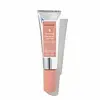What's inside
What's inside
 Key Ingredients
Key Ingredients

 Benefits
Benefits

 Concerns
Concerns

 Ingredients Side-by-side
Ingredients Side-by-side

Water
Skin ConditioningGlycerin
HumectantLauric Acid
CleansingPalmitic Acid
EmollientStearic Acid
CleansingMyristic Acid
CleansingPotassium Hydroxide
BufferingCocamidopropyl Betaine
CleansingPEG-100 Stearate
Glyceryl Stearate
EmollientBeeswax
Emulsion StabilisingButylene Glycol
HumectantPrunus Persica Fruit Extract
AbrasiveSodium Hyaluronate
HumectantSolanum Lycopersicum Fruit Extract
AntioxidantPunica Granatum Fruit Extract
AntioxidantHippophae Rhamnoides Extract
MaskingBeta Vulgaris Root Extract
Skin ConditioningSorbitan Olivate
EmulsifyingSodium Chloride
MaskingArachidic Acid
CleansingCapric Acid
CleansingOleic Acid
EmollientCaprylyl Glycol
EmollientDisodium EDTA
Sodium Benzoate
Masking1,2-Hexanediol
Skin ConditioningEthylhexylglycerin
Skin ConditioningParfum
MaskingLinalool
PerfumingBenzyl Benzoate
AntimicrobialLimonene
PerfumingWater, Glycerin, Lauric Acid, Palmitic Acid, Stearic Acid, Myristic Acid, Potassium Hydroxide, Cocamidopropyl Betaine, PEG-100 Stearate, Glyceryl Stearate, Beeswax, Butylene Glycol, Prunus Persica Fruit Extract, Sodium Hyaluronate, Solanum Lycopersicum Fruit Extract, Punica Granatum Fruit Extract, Hippophae Rhamnoides Extract, Beta Vulgaris Root Extract, Sorbitan Olivate, Sodium Chloride, Arachidic Acid, Capric Acid, Oleic Acid, Caprylyl Glycol, Disodium EDTA, Sodium Benzoate, 1,2-Hexanediol, Ethylhexylglycerin, Parfum, Linalool, Benzyl Benzoate, Limonene
Homosalate 10%
Skin ConditioningEthylhexyl Salicylate 5%
UV AbsorberButyl Methoxydibenzoylmethane 3%
UV AbsorberWater
Skin ConditioningButyloctyl Salicylate
Skin ConditioningC12-15 Alkyl Benzoate
AntimicrobialCalcium Sodium Borosilicate
Glycerin
HumectantGlyceryl Stearate
EmollientEthylhexyl Methoxycrylene
Skin ConditioningVp/Eicosene Copolymer
Stearyl Dimethicone
EmollientArgania Spinosa Kernel Oil
EmollientTocopheryl Acetate
Antioxidant1,2-Hexanediol
Skin ConditioningNiacinamide
SmoothingTocopherol
AntioxidantCetearyl Olivate
Bisabolol
Masking3-O-Ethyl Ascorbic Acid
Skin ConditioningSodium Hyaluronate
HumectantSqualane
EmollientAmmonium Acryloyldimethyltaurate/Vp Copolymer
Hydroxyacetophenone
AntioxidantSilica
AbrasiveSodium Stearoyl Glutamate
CleansingOctadecene
SolventSorbitan Olivate
EmulsifyingSorbitan Oleate
EmulsifyingCaprylyl/Capryl Glucoside
CleansingXanthan Gum
EmulsifyingSodium Acrylate/Sodium Acryloyldimethyl Taurate Copolymer
Emulsion StabilisingTrisodium Ethylenediamine Disuccinate
Polyisobutene
Citric Acid
BufferingSodium Hydroxide
BufferingHomosalate 10%, Ethylhexyl Salicylate 5%, Butyl Methoxydibenzoylmethane 3%, Water, Butyloctyl Salicylate, C12-15 Alkyl Benzoate, Calcium Sodium Borosilicate, Glycerin, Glyceryl Stearate, Ethylhexyl Methoxycrylene, Vp/Eicosene Copolymer, Stearyl Dimethicone, Argania Spinosa Kernel Oil, Tocopheryl Acetate, 1,2-Hexanediol, Niacinamide, Tocopherol, Cetearyl Olivate, Bisabolol, 3-O-Ethyl Ascorbic Acid, Sodium Hyaluronate, Squalane, Ammonium Acryloyldimethyltaurate/Vp Copolymer, Hydroxyacetophenone, Silica, Sodium Stearoyl Glutamate, Octadecene, Sorbitan Olivate, Sorbitan Oleate, Caprylyl/Capryl Glucoside, Xanthan Gum, Sodium Acrylate/Sodium Acryloyldimethyl Taurate Copolymer, Trisodium Ethylenediamine Disuccinate, Polyisobutene, Citric Acid, Sodium Hydroxide
 Reviews
Reviews

Ingredients Explained
These ingredients are found in both products.
Ingredients higher up in an ingredient list are typically present in a larger amount.
1,2-Hexanediol is a synthetic liquid and another multi-functional powerhouse.
It is a:
- Humectant, drawing moisture into the skin
- Emollient, helping to soften skin
- Solvent, dispersing and stabilizing formulas
- Preservative booster, enhancing the antimicrobial activity of other preservatives
Glycerin is already naturally found in your skin. It helps moisturize and protect your skin.
A study from 2016 found glycerin to be more effective as a humectant than AHAs and hyaluronic acid.
As a humectant, it helps the skin stay hydrated by pulling moisture to your skin. The low molecular weight of glycerin allows it to pull moisture into the deeper layers of your skin.
Hydrated skin improves your skin barrier; Your skin barrier helps protect against irritants and bacteria.
Glycerin has also been found to have antimicrobial and antiviral properties. Due to these properties, glycerin is often used in wound and burn treatments.
In cosmetics, glycerin is usually derived from plants such as soybean or palm. However, it can also be sourced from animals, such as tallow or animal fat.
This ingredient is organic, colorless, odorless, and non-toxic.
Glycerin is the name for this ingredient in American English. British English uses Glycerol/Glycerine.
Learn more about GlycerinGlyceryl Stearate is a mix of glycerin and stearic acid.
It is used to stabilize the mixing of water and oil ingredients. By preventing these ingredients from separating, it can help elongate shelf life. It can also help thicken the product's texture.
As an emollient, it helps soften skin and supports barrier-replenishing ingredients.
In cosmetics, Glyceryl Stearate is often made from vegetable oils or synthetically produced.
This ingredient may not be fungal-acne safe
Fun fact: The human body also creates Glyceryl Stearate naturally.
Learn more about Glyceryl StearateSodium Hyaluronate is hyaluronic acid's salt form. It is commonly derived from the sodium salt of hyaluronic acid.
Like hyaluronic acid, it is great at holding water and acts as a humectant. This makes it a great skin hydrating ingredient.
Sodium Hyaluronate is naturally occurring in our bodies and is mostly found in eye fluid and joints.
These are some other common types of Hyaluronic Acid:
Learn more about Sodium HyaluronateSorbitan Olivate is created from the fatty acids in olive oil and sorbitol.
This ingredient is an oil in water emulsifier. It helps stabilize a product by preventing oils and waters from separating. Sorbitan Olivate also helps hydrate the skin.
Manufacturers sell sorbitan olivate under the name OliveM 1000. OliveM 1000 a multifunctional ingredient. It is self-emulsifying. According to a manufacturer, OliveM 1000 does not disrupt natural skin biome.
Due to its olive oil base, this ingredient may not be fungal-acne safe.
Learn more about Sorbitan OlivateWater. It's the most common cosmetic ingredient of all. You'll usually see it at the top of ingredient lists, meaning that it makes up the largest part of the product.
So why is it so popular? Water most often acts as a solvent - this means that it helps dissolve other ingredients into the formulation.
You'll also recognize water as that liquid we all need to stay alive. If you see this, drink a glass of water. Stay hydrated!
Learn more about Water